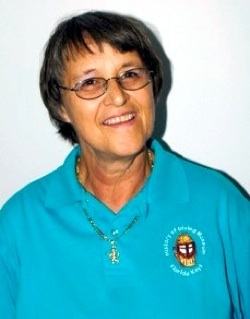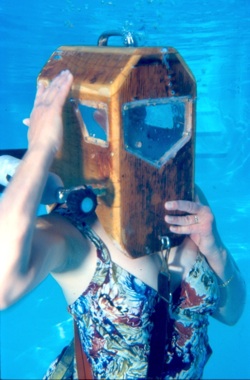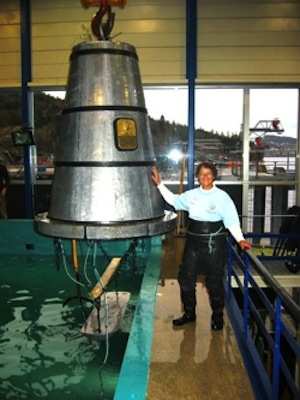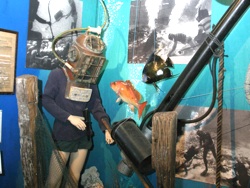Sally Bauer: Diving into Underwater History
By Christina Baez Florida Keys News Bureau
ISLAMORADA, Florida Keys — In the late 1960s, Sally and Joe Bauer made a road-trip pit stop that changed their lives forever. Driving back from diving in the Keys, they stopped at a store near the Miami airport called Stone Age Antiques.
There they found an old diving helmet selling for $500, and purchased it because they thought it was attractive. That transaction set them on a path that eventually led to their founding the Florida Keys History of Diving Museum in Islamorada.
"When we purchased that helmet, we caught the collecting bug," Sally said. "Like any incurable disease, it can't be treated. You can suppress the strength of it a little bit — in this case by adding to the collection — but you never quite get over it."
Over the years, the Bauers compiled the world's largest collection of diving artifacts, antiques, books and prints related to the history of diving.
Sally grew up in a rural area near Youngstown, Ohio, in a working-class family. She went on to study medicine and met her husband of 42 years, the late Joe Bauer, when she showed up at his office seeking a summer job while in college.
"I started working for him, and then I worked for and with him all of the rest of his life," she said. "We did everything together; that was my joy through life and my great tragedy when he died."
Sally and Joe began diving as a hobby that enabled them to disconnect from the world and escape the stresses of the medical profession. What kept them diving, however, was their fascination with the marine biology of aquarium fish.
The Bauers took drive trips to the Keys to study the spawning behaviors of fish and bring them back to their Cleveland home for further research. Credited with the discovery of certain fish spawning habits, they also were the first to raise clownfish and peppermint shrimp successfully in captivity.
By the 1980s, their collection of artifacts was so extensive that they co-authored a chapter of "The Pictorial History of Diving" and helped found the Historical Diving Society of the United States and the United Kingdom.
Fearing their collection and the history it represented would be dispersed and lost after their deaths, they approached the Smithsonian Institute, Disney's Epcot Center and others — but those venues expressed little interest in it.
"When we moved to the Keys full-time in 1997, we realized that the Keys are the only place that you can drive and dive on a coral reef," Sally said. "It just seemed natural that this is where we should have the museum."
The Florida Keys History of Diving Museum was established as a not-for-profit educational institution in 2000. After a long search the Bauers found a suitable building for it at mile marker 83, and opened one exhibit every month from September 2005 to September 2006.
Today, the museum contains artifacts and ephemera covering 4,000 years of diving history. Highlights include an exhibit of dive helmets from around the world, and one dedicated to Upper Keys treasure hunter Art "Silver Bar" McKee.
"The museum is not just for divers — it's for anyone who wants to know more about man's quest to explore under the sea," Sally explained. "Joe used to say, 'It's a little jewel that has not quite been discovered,' and when people come in they're astonished."
Joe Bauer died suddenly in April 2007, leaving behind his legacy and knowledge of diving history with Sally.
"My challenge for the rest of my life is to put this history down so it's not lost," Sally said. "The museum is open, but you never want it to be finished — there are many more stories we want to tell about diving history."
Currently president of the museum's board of directors, Sally is working on sharing the story of man's underwater exploration by establishing the Bauer Research Library as a resource for scholars, historians and museum members.
Sally's impact on the diving world was exemplified by her March 2011 induction into the Women Divers Hall of Fame.
"I am really so honored to be a part of this remarkable group of women, many of whom are my absolute heroes who I really admire and respect," she said. "I'm very pleased that a diving historian has been recognized — and this is an opportunity for me to showcase the History of Diving Museum in another venue."

Sally's impact on the diving world was exemplified by her March 2011 induction into the Women Divers Hall of Fame. Photos courtesy of the History of Diving Museum

Bauer, diving underwater in a wooden Griswood helmet.

Bauer stands beside a diving bell after a dive in Norway in 2005.

Today, the museum contains artifacts and ephemera covering 4,000 years of diving history. Highlights include an exhibit of dive helmets from around the world, and one dedicated to Upper Keys treasure hunter Art "Silver Bar" McKee.
